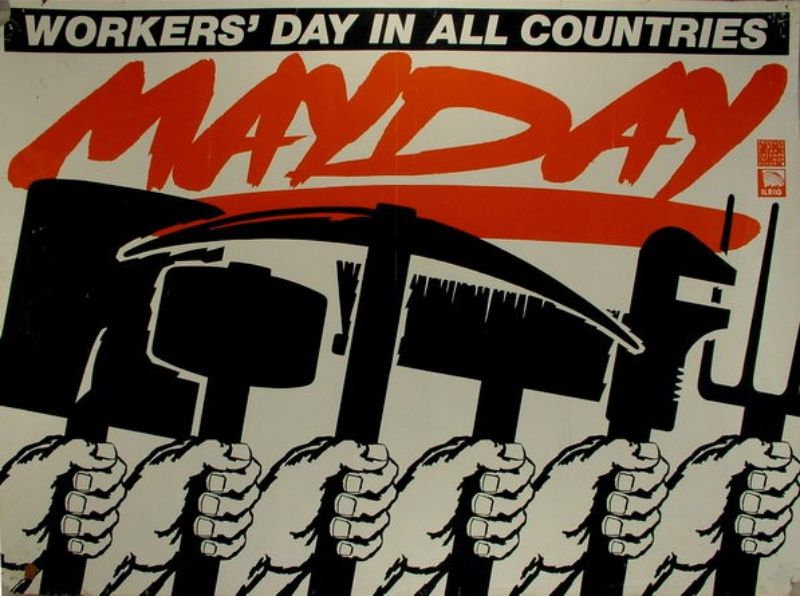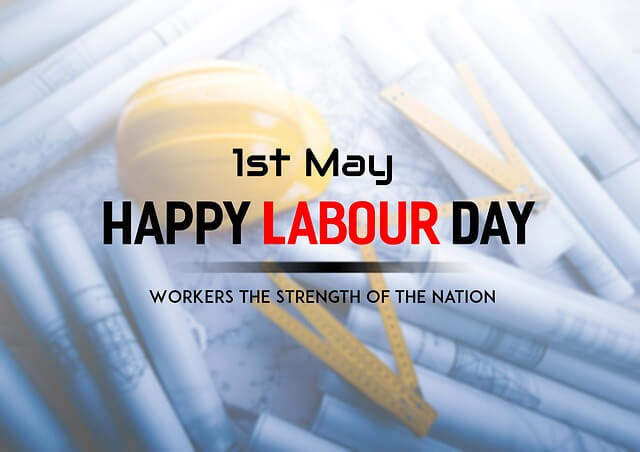Most people living in the United States know little about May Day International Workers Day. For many others there is an assumption that it is a holiday celebrated in communist states such as Cuba or the Russia.
Most Americans do not realize that May Day has its origins here in this country and is as “American” as baseball and apple pie, and originated from Beltane’s pre-Christian vacation, a celebration of rebirth and fertility.

At the end of the 19th century, the working class was constantly struggling to obtain an 8-hour workday. Working conditions were severe and it was quite common to work 10 to 16 hours per day in unsafe conditions. Death and injuries were common in many workplaces and inspired books such as The Jungle by Upton Sinclair and The Iron Heel by Jack London. Already in the 1860s, workers were agitated to shorten the day of work without a wage cut, but it was not until the late 1880s that organized labor could gather enough strength to declare the working day of 8 hours. This proclamation was without the consent of the employers, but demanded by many of the working class.
At this time, socialism was a new and attractive idea for the workers, many of whom were attracted by their ideology of the control of the working class over the production and distribution of all goods and services. The workers had seen first hand that Capitalism benefited only its bosses, exchanging workers’ lives for profit. Thousands of men, women and children died unnecessarily every year in the workplace, with a life expectancy as low as twenty years in some industries and with little hope, except death, to get out of their misery. Socialism offered another option.
A variety of socialist organizations emerged throughout the second half of the nineteenth century, from political parties to choral groups. In fact, many socialists were elected to the government office by their constituency. But, once again, many of these socialists were trapped by the political process, which was so evidently controlled by big business and the bipartisan political machine. Tens of thousands of socialists broke ranks of their parties, rejected the entire political process, which was nothing but protection for the rich, and created anarchist groups throughout the country. Literally, thousands of working people embraced the ideals of anarchism, which sought to put an end to all hierarchical structures (including government), emphasized the industry controlled by workers and valued direct action on the bureaucratic political process. It is inaccurate to say that the trade unions were “taken” by anarchists and socialists, but that the anarchists and socialists formed the unions.
At its national convention in Chicago, held in 1884, the Federation of Organized Merchants and Trade Unions (which later became the American Federation of Labor) proclaimed that “eight hours will constitute one-day legal work as of May 1. 1886. ” The following year, FOTLU, backed by many of the Knights of Labor’s locals, reiterated its proclamation stating that it would be backed by strikes and demonstrations. At first, most radicals and anarchists considered that this demand was too reformist and failed to attack “the root of evil.” A year before the Haymarket Massacre, Samuel Fielden noted in the anarchist newspaper The Alarm that “if a man works eight hours a day or ten hours a day, he is still a slave.”
Despite the doubts of many of the anarchists, an estimated one quarter of a million workers in the Chicago area were directly involved in the crusade to implement the eight-hour workday, including the Trade and Labor Assembly, the Party Socialist Labor and the local Labor Knights. As more and more workers mobilized against the employers, these radicals agreed to fight during the 8-hour day, realizing that “the current of opinion and determination of the majority of salaried workers was established in this direction”. With the participation of the anarchists, there seemed to be an infusion of problems greater than the 8-hour day. A sense of greater social revolution grew beyond the more immediate gains of shortened hours, but a drastic change in the economic structure of capitalism.

Source : pixabay.com
In a printed proclamation just before May 1, 1886, an editor appealed to the workers with this argument:
Workers to arms!
War to the Palace, Peace to the Cabin, and Death to LUXURY IDENTITY.
The salary system is the only cause of the world’s misery. It is supported by the rich classes, and to destroy it, they must be made to work or DIE.
One pound of DYNAMITE is better than a bunch of BALLOTS!
MAKE YOUR DEMAND FOR EIGHT HOURS with weapons in your hands to meet the capitalist bloodhounds, the police and the militia in an appropriate manner.
Not surprisingly, the entire city was prepared for a massive bloodshed, reminiscent of the railway attack a decade earlier, when hundreds of striking workers were shot dead by police and soldiers. On May 1, 1886, more than 300,000 workers in 13,000 businesses throughout the United States left their jobs at the first May Day celebration in history. In Chicago, the epicenter of the 8-hour day agitators, 40,000 went on strike with the anarchists in front of the public eye. With their ardent speeches and revolutionary ideology of direct action, the anarchists and anarchism were respected and adopted by the workers and despised by the capitalists.
The names of many: Albert Parsons, Johann Most, August Spies and Louis Lingg, became familiar words in Chicago and throughout the country. Parades, gangs and tens of thousands of protesters in the streets exemplified the strength and unity of the workers, but did not become violent as predicted by the newspapers and the authorities.
More and more workers continued to leave their jobs until the numbers increased to almost 100,000, however, peace prevailed. It was not until two days later, on May 3, 1886, that violence erupted at the McCormick Reaper Works between the police and the strikers.
For six months, the Pinkerton armed agents and the police harassed and beat the ironworkers who were locked up when they were picketing. The majority of these workers belonged to the Metalworkers’ Union “dominated by the anarchists”. During a speech near the McCormick plant, about two hundred protesters joined steelworkers at the picket line. The beatings with the police clubs turned into rock throws by the strikers, whom the police responded with gunshots. At least two strikers were killed and an unknown number was injured.
Filled with rage, some anarchists called a public meeting for the next day in Haymarket Square to talk about police brutality. Due to bad weather and short notice, only about 3000 of the tens of thousands of people showed up from the previous day. This issue included families with children and the mayor of Chicago. Later, the mayor would testify that the crowd remained calm and orderly and that the speaker August Spies “made no suggestion … for the immediate use of force or violence towards anyone …”

Source : pixabay.com
When the speech ended, two detectives rushed to the main body of the police, reporting that a speaker used incendiary language, prompting the police to march on the speakers’ wagon. When the police began to disperse the already weakened crowd, a bomb was thrown into the ranks of the police. Nobody knows who threw the bomb, but the speculations varied from blaming any of the anarchists, to a provocative agent who works for the police.
Enraged, the police fired into the crowd. The exact number of civilians killed or wounded was never determined, but it is estimated that seven or eight civilians were killed and up to forty were injured. One officer died immediately and seven others died in the following weeks. Subsequent evidence indicated that only one of the police deaths could be attributed to the bomb and that all other police deaths had or could have been due to their own indiscriminate firearms. Apart from the bomb thrower, which was never identified, it was the police, not the anarchists, who perpetrated the violence.
Eight anarchists – Albert Parsons, August Spies, Samuel Fielden, Oscar Neebe, Michael Schwab, George Engel, Adolph Fischer and Louis Lingg – were arrested and convicted of murder, although only three were present in Haymarket and those three were in full view of everything when the bombing happened. The jury in his trial was composed of business leaders in a great mockery of justice similar to the Sacco-Vanzetti case thirty years later, or the trials of the members of AIM and Black Panther in the seventies. The whole world saw how these eight organizers were condemned, not for their actions, of which they were all innocent, but for their political and social beliefs. On November 11, 1887, after many failed appeals, Parsons, Spies, Engel and Fisher were hanged. Louis Lingg, in his final protest of the state’s claim of authority and punishment, took his life the night before with an explosive device in his mouth.
The remaining organizers, Fielden, Neebe and Schwab, were pardoned six years later by Governor Altgeld, who publicly attacked the judge for a parody of justice. Immediately after the Haymarket Massacre, the big companies and the government carried out what some say was the first “red scare” in this country. Turned by conventional means, anarchism became synonymous with bomb throwing and socialism became anti-American. The common image of an anarchist turned into a bearded immigrant from Eastern Europe with a bomb in one hand and a dagger in the other.
Today we see tens of thousands of activists embrace the ideals of the Haymarket Martyrs and those who established May Day as an International Workers’ Day. Ironically, May Day is an official holiday in 66 countries and is celebrated unofficially in many more, but it is rarely recognized in this country where it began.
It’s been over a hundred years since that first day in May. In the first part of the 20th century, the government of the USA. He tried to stop the celebration and erase it from public memory by establishing the “Day of Law and Order” on May 1. We can draw many parallels between the events of 1886 and today. We still have blocked steel workers fighting for justice. We still have voices of freedom behind bars, as in the cases of Mumia Abu Jamal and Leonard Peltier. We still had the ability to mobilize tens of thousands of people on the streets of a big city to proclaim “THIS IS WHAT DEMOCRACY APPEARS!” in the demonstrations of the WTO and the FTAA.
The strongest words that anyone who could write are recorded at the Haymarket Monument:
THE DAY WILL COME WHEN OUR SILENCE WILL BE MORE POWERFUL THAN THE VOICES YOU ARE PASSING TODAY.
In truth, history has much to teach us about the roots of our radicalism. When we remember that people were shot so that we could have the 8 hour day; if we recognize that the homes with families in them were completely burned so that we could have the Sabbath as part of the weekend; When we remember victims of industrial accidents of 8 years who marched in the streets protesting the conditions of work and child labor to be beaten by the police and the company’s thugs, we understand that our current condition can not be taken for granted: people they fought for the rights and dignities that we enjoy today, and there is still much to fight for. The sacrifices of so many people can not be forgotten or we will end up fighting for those same achievements once again. That’s why we celebrate May Day.

Source : pixabay.com
May Day Messages
“Always be a hardworking soul, since nothing good is easy in life …. So make the best of your efforts to achieve your goals … Happy May Day !!!”
“The brightness of the flowers can extend in your life smiles and happiness …. I wish you a very nice and energetic May Day … May each and every one of the days of your life be as beautiful as the lovely May” .
“May Day is the day to salute the hard work and dedication of the strong and dear souls that surround us … I wish you a very blessed May Day.”
“Let’s make this land a great land with our hard work and determination … Let’s make our country feel proud with our work … Warm greetings to you on May Day.”